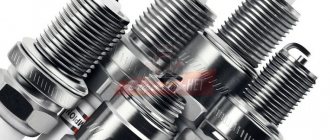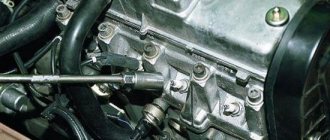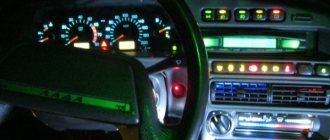Very often, owners of domestic cars are faced with such a problem as flooded spark plugs. Despite the fact that it can be solved quite quickly, many, especially novice motorists, do not know how to do it correctly. In today's article we will figure out why the VAZ 2114 is flooded with spark plugs, and we will tell you how to fix this problem yourself.
Spark plugs VAZ 2114
Why the spark plugs on the injector flood: TOP-5
A mixture containing gasoline and air in a certain proportion must burn in the cylinders. Excessive enrichment results in incomplete combustion, causing stalling or unsuccessful starting attempts. But if we talk about “injectors,” excessive leanness of the mixture also leads to the same result. Any of two factors causes the spark plugs to flood with fuel - black smoke comes from the chimney, popping noises are heard... And in winter, the spark plugs on the injector can be flooded for other reasons: low evaporation coefficient, non-zero water content.
One of the reasons why the effect appears in winter is that the heat value is too high. Example on video.
Fighting flooded candles
If the spark plugs on your car are flooded and the engine does not start, there is no reason to panic, you just need to do a few manipulations and the engine will undoubtedly start.
Cleaning spark plugs from fuel
First of all, if the car does not start, then you need to blow out the spark plugs with air without fuel, for this:
- Turn on the ignition on the car;
- We press the gas pedal to the floor;
- Turn the starter for 10 seconds;
- Release the pedal and try to start the car;
If this does not help, then you need to burn the candles, for this:
- Remove the wires and unscrew the spark plugs;
- We burn candles over an open fire or using a hairdryer;
- We screw in the spark plugs and start the engine;
This action will definitely bring a positive result, unless of course the battery is discharged.
Accumulator battery
If the starter turns rather sluggishly, then you will not be able to start the car; you need to charge the battery or use the wires to “light it”.
Studying plaque on candles
They say that when candles are “flooded,” black soot forms. Let us clarify: it should not consist of inclusions. All metal, in turn, will be covered with an oily coating. Dry carbon looks different...
Oily layer and dry soot
The photo shows two cases. “Our version” is on the right.
And soot can also be brown. And it always, in 100% of cases, is formed due to pouring gasoline.
Dark brown soot
An oily coating, as in photo 1, is, nevertheless, the result of oil ingress. But an oiled candle does not work correctly - it will also be “flooded”.
With regular “flooding,” carbon deposits form, which we see in photo 1 on the right and in photo 2. The rest does not apply to our case.
Other reasons
In addition to the already mentioned main reason for flooding candles, there may be others:
- When starting, the crankshaft turns slowly (we are repairing the crankshaft).
- The malfunction lies in the valve stem seals, which allow oil to pass through (we change the valve stem seals).
- The injector is clogged, but continues to supply gasoline and fills the spark plugs with it (we clean the injector).
- Water appears in gasoline (this happens most often in winter, we choose the right brand of gasoline - “winter” or “summer”).
We are looking for reasons why the spark plugs on the injector are flooded
Both lean and too rich mixtures cause the engine to stall. But the ECU cannot be wrong... The injectors, in turn, may be clogged - everything is clear here. And in cold weather, the valve may not close well due to ice formed.
Gasoline stain on the water
Conclusion: It is advisable to use fuel with zero water content. A carburetor filled with water may simply freeze, and each of the four (six, eight) injectors will flood the spark plugs at startup.
Main list
The main reasons why the engine floods the spark plugs include the following:
- In winter - the presence of water in gasoline;
- The evaporation coefficient must correspond to the air temperature (season). There is “summer” and “winter” gasoline. By the way, the indicated coefficient has nothing to do with the octane number;
- Clogged injectors are the reason for preparing a lean mixture;
- Slow cranking at start-up is also a common cause;
- Faulty valve stem seals contribute to the presence of oil in the combustible mixture.
When adding ferrocene additives, the second reason is aggravated. And they fight the fourth reason by moving to using the “right” oils. The material should not freeze in cold weather.
Recommended SAE ratios: 0W, 5W, but not 10W.
How to avoid flooding candles
Emergency resuscitation of spark plugs in winter (especially when you need to drive urgently) is not the most pleasant experience. That is why it is best to avoid it altogether by taking appropriate measures.
The first thing you need to do is not to save on fuel and lubricants. If in summer fuel and oil of poor quality do not significantly affect engine performance, then in winter the difference will be obvious. For the same reason, it is recommended to refuel only at trusted gas stations, especially in cold weather.
Gasoline for VAZ 2114
As for the oil, it must be fully consistent with the season and the lowest possible temperature. Using summer oil in frosty weather can dramatically increase the load on the moving parts of the engine, and cause not only flooding of spark plugs, but also other, more serious problems.
Popular brands of oil for VAZ 2114
The second thing you need to pay attention to is the condition of the candles. If they are flooded not only in winter, but also in the warm season, then it is obvious that they are faulty. To begin with, you can try to restore them - clean the deposits, remove oxides, check and, if necessary, adjust the gap between the electrodes.
Cleaned and uncleaned candles
If this does not help, then the spark plugs need to be replaced (do not forget that you always need to replace all 4 spark plugs, even if only one is to blame for the problem).
The third thing you need to do in order to avoid flooding the spark plugs is to always check the condition of the battery and recharge it before leaving.
VAZ 2114 battery
Also, when starting the engine in very cold weather, it is recommended to first load the battery, wait a while and turn it off for 10 minutes, then try to start the engine. If this fails, then you should wait another 10 minutes and try again.
The last thing to worry about is the condition of the engine. To prevent carbon deposits from settling in it, it is recommended to go to the highway once a month and drive along it for about 15 minutes at a speed of 120 km/h. This procedure helps clean the engine very well due to the consistently high pressure generated in it.
If such cleaning on the go is not possible due to road conditions, then you can run the engine several times a month before starting the trip at 5,000 rpm.
Thus, by following the simple rules given above, you can completely rid yourself and your car of such a problem as candles flooded in the cold season.
How they do it in practice
You can start a fuel-injected internal combustion engine in winter with both winter and summer fuel. It’s just that in the second case the mixture will have to be made leaner. The question is how to achieve this... For example, you can flash a “winter” program. Or do this:
- Before starting the engine, the temperature sensor is temporarily disabled. Instead, a sensor heated in the hands is put on the plug;
- We are trying to turn on the starter... The ECU “thinks” that the engine is warmed up and prepares a leaner mixture than it should.
Note that the DTOZh sensor will be attached to the thermostat.
Connector DTOZH ECU, VAZ-2114 car
If the number of sensors exceeds 1, disconnect the one to which two wires go. It is always connected to the ECU.
Fuel with low volatility does not combine well with cold air - the mixture turns out to be heterogeneous. But if the concentration is lowered, the problem is solved.
Cold start problems
Troubles with ignition often occur in the cold season. If the car is stored open, a frosty morning can bring trouble to the car owner.
The problem can be identified by some indirect signs:
- There is rotation of the crankshaft by the starter, but there is no seizure;
- a distinct smell of gasoline spreads through the exhaust system, which is audible especially when the starter rotates;
- Having unscrewed the spark plugs, you can notice fuel residues not only on the electrodes, but also on the threads, and the underside is covered with dark soot.
It is important to know that the injector fills the spark plugs with gasoline in cold weather much less often than carburetor counterparts do.
There are certain features when filling spark plugs in a car with an injection power system and a carburetor, but in both cases the common feature is the presence of fuel entering the chamber and the absence of its ignition. In this case, the contacts end up in liquid, sparking does not occur, and further normal operation of the motor becomes impossible.
Flooding when there is a spark and the starter is rotating
Experienced motorists are faced with situations when a spark appears, the starter rotates, but the lower part of the spark plugs is filled with gasoline. Do not be deluded by the presence of a fire, since this event can occur irregularly under pressure and can be lost while the engine is running.
The cause of the event appears to be excessive pressure in the cylinders. It will be possible to identify the event and the factors that motivate it by monitoring the car on a stand that simulates a combustion chamber.
We recommend paying attention to the valve timing, because their failure will be the cause of wet electrodes . In injection internal combustion engines, motorists should check the functionality of the bypass valve located on the fuel rail. If its malfunctions are ruled out, you will need to find out the gasoline pressure in the rail, because the manufacturer regulates this parameter. Sharp fluctuations and going beyond the specified interval (larger/smaller sides) can block the start of the internal combustion engine or stimulate flooding of contacts for spark ignition.
Diagnostics will need to be carried out for the sensors of the electronic control system and for the injectors. An example of a failure is when the coolant temperature sensor sends incorrect data. In such a situation, the control unit unreasonably over-enriches the fuel mixture. Much less often, the culprit of incorrect impulses is a failed electronic control unit or a malfunction of its software. In this case, problems will appear not only with the ignition.











